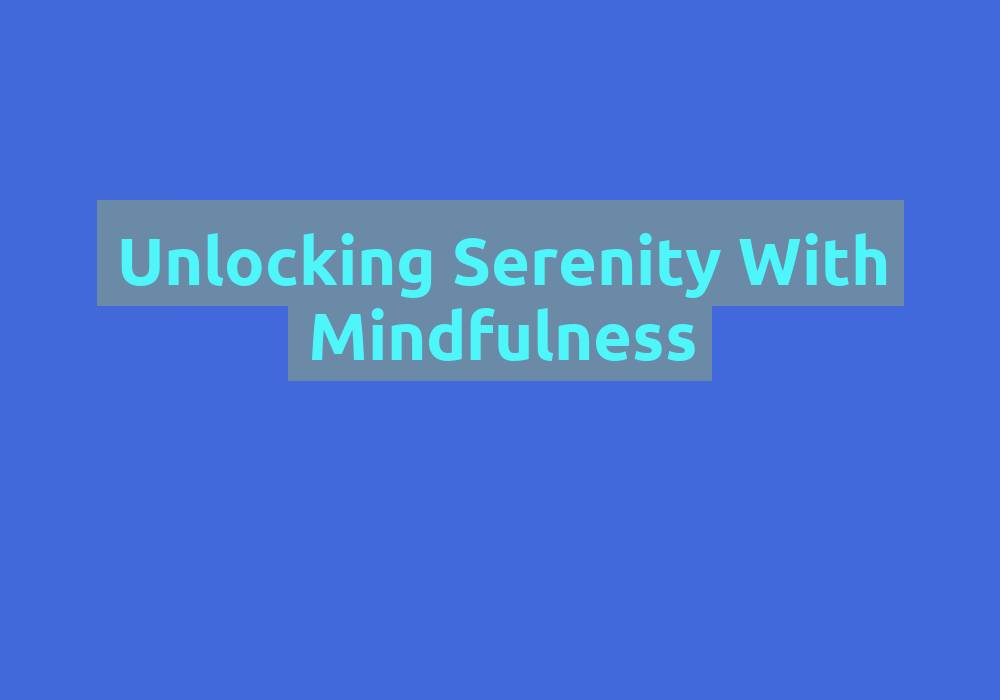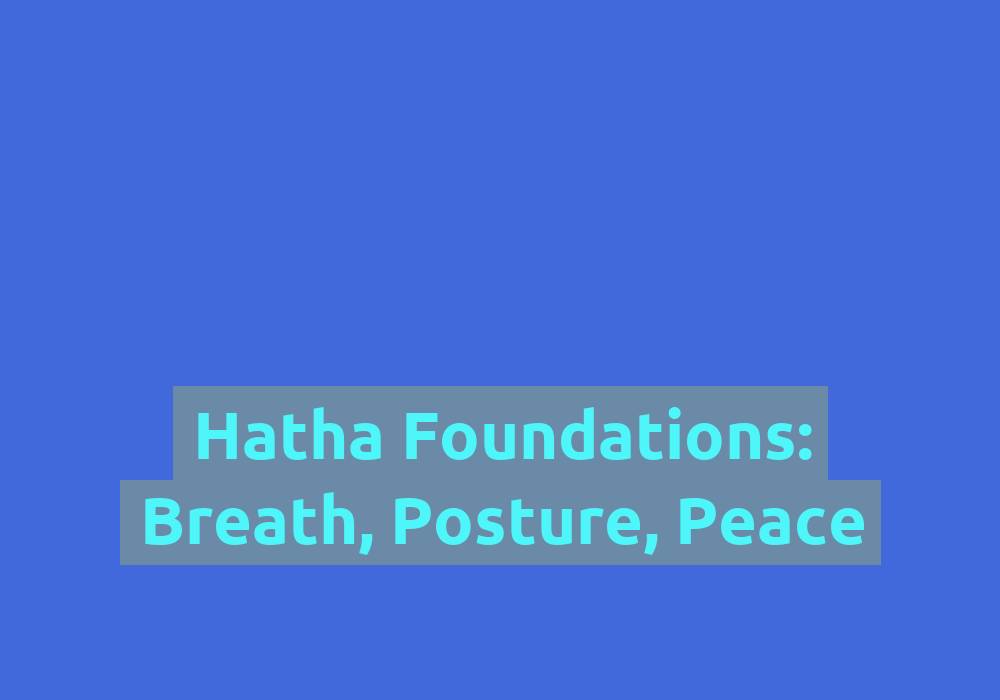Unlocking Serenity with Mindfulness

Mindfulness is a powerful practice that allows individuals to focus their attention on the present moment, cultivating a state of awareness and acceptance. By incorporating mindfulness into our daily lives, we can unlock a sense of serenity and find peace amidst the chaos of modern living. In this article, we will explore the benefits of mindfulness and provide practical tips on how to integrate it into your daily routine.
The Power of Mindfulness
Mindfulness has gained significant attention in recent years due to its proven ability to reduce stress, improve mental well-being, and enhance overall quality of life. By practicing mindfulness, we can tap into our inner resources and develop a greater understanding of our thoughts, emotions, and sensations.
Benefits of Mindfulness
- Reduced Stress: Mindfulness helps to cultivate a sense of calm and tranquility by promoting relaxation and reducing stress levels. By focusing on the present moment, we can alleviate anxiety and worry about the past or future.
Mindfulness not only allows us to acknowledge and let go of stress-inducing thoughts, but it also helps us develop a different perspective on stress itself. By observing our thoughts and emotions without judgment, we can cultivate a sense of detachment from stressful situations. This enables us to respond to stressors more effectively and make conscious choices that promote well-being.
- Improved Mental Health: Mindfulness has been shown to be effective in managing various mental health conditions, including depression, anxiety, and PTSD. It allows individuals to develop a non-judgmental attitude towards their thoughts and emotions, fostering self-compassion and acceptance.
By practicing mindfulness, we can become more aware of our mental patterns and identify negative thought patterns that contribute to mental health issues. With this awareness, we can challenge and reframe these thoughts, promoting a more positive and compassionate mindset. Mindfulness also encourages us to seek professional help when needed and engage in self-care practices that support our mental well-being.
- Enhanced Emotional Well-being: By practicing mindfulness, we can develop emotional resilience and regulate our emotions more effectively. It helps us recognize and respond to our emotions in a healthy and balanced manner.
When we cultivate mindfulness, we become more attuned to our emotional experiences. Instead of reacting impulsively to our emotions, we can observe them with curiosity and compassion. This allows us to choose how we respond to our emotions, rather than being overwhelmed or controlled by them. Mindfulness empowers us to develop healthier coping mechanisms and cultivate a greater sense of emotional well-being.
- Increased Focus and Concentration: Mindfulness enhances our ability to pay attention and concentrate on the task at hand. It improves cognitive abilities, memory, and decision-making skills, thereby boosting productivity and performance.
When we practice mindfulness, we train our minds to stay present and fully engaged in the present moment. This heightened state of awareness allows us to be more focused and attentive to our surroundings, reducing distractions and improving our ability to concentrate. By sharpening our cognitive abilities, mindfulness enables us to make better decisions and enhances our overall productivity and performance.
- Improved Relationships: Mindfulness enhances our interpersonal relationships by promoting empathetic listening, effective communication, and understanding. It helps us cultivate deeper connections with others and fosters a sense of compassion and empathy.
When we practice mindfulness in our relationships, we become more present and attentive to the needs and experiences of others. By truly listening and being fully engaged in conversations, we show genuine empathy and create a safe space for open communication. Mindfulness also helps us become more aware of our own reactions and responses, allowing us to choose more thoughtful and compassionate ways of relating to others.
Integrating Mindfulness into Daily Life
Now that we understand the benefits of mindfulness, let’s explore practical ways to incorporate it into our daily routine:
1. Mindful Breathing
Begin by focusing on your breath. Take a few deep breaths, paying attention to the sensation of the breath entering and leaving your body. Notice any thoughts or distractions that arise, and gently bring your attention back to the breath. Practice this for a few minutes each day, gradually increasing the duration as you become more comfortable.
In addition to practicing mindful breathing as a standalone exercise, you can also incorporate it into your daily activities. For example, take a few moments to focus on your breath before starting a task or during transitions between activities. This allows you to bring a sense of calm and presence into your daily life.
2. Mindful Eating
Engage in mindful eating by savoring each bite, paying attention to the taste, texture, and aroma of the food. Slow down and chew your food thoroughly, noticing the sensations in your mouth and the act of swallowing. This helps cultivate a deeper connection with the food we consume and promotes healthy eating habits.
In addition to being present while eating, you can also practice gratitude for the nourishment that food provides. Take a moment to appreciate the effort that went into growing, preparing, and serving the food. By savoring each bite and expressing gratitude, you enhance the experience of eating and develop a more mindful approach to nourishing your body.
3. Mindful Movement
Incorporate mindfulness into your daily physical activities, such as walking or yoga. Pay attention to the sensations in your body as you move, the feeling of your feet touching the ground, or the stretch of your muscles. This helps to bring your focus to the present moment and increases body awareness.
While engaging in mindful movement, you can also observe the thoughts and emotions that arise during these activities. Notice how your body feels and the impact of movement on your mood and energy levels. This integration of mindfulness and movement allows you to fully experience the benefits of both practices.
4. Mindful Technology Use
In today’s digital age, we are often consumed by our screens and devices. Practice mindful technology use by setting aside dedicated time each day to disconnect from technology. Engage in activities that promote mindfulness, such as reading, journaling, or spending time in nature.
Creating boundaries around technology use allows us to break free from constant distractions and be fully present in the moment. Set specific times during the day where you disconnect from technology and engage in activities that nourish your mind and soul. By consciously choosing how we interact with technology, we can create a healthier balance in our lives.
5. Mindful Relationships
Apply mindfulness principles to your interactions with others. Practice active listening, being fully present in conversations, and offering genuine empathy and support. Cultivate a non-judgmental attitude and be mindful of your own reactions and responses.
When engaging in conversations, practice deep listening by giving your full attention to the speaker. Avoid distractions and truly focus on understanding their perspective. Respond with empathy and kindness, fostering an atmosphere of trust and understanding. By being mindful in our relationships, we can cultivate deeper connections and create a more harmonious social environment.
Final Thoughts
Incorporating mindfulness into our daily lives can have profound effects on our well-being and overall sense of serenity. By practicing mindfulness, we can unlock a deep sense of peace and clarity, allowing us to navigate life’s challenges with greater ease. Take the time to cultivate mindfulness in your daily routine, and witness the transformative power it brings to your life.
Please note that the format provided above is not in markdown format. To convert it to markdown, simply add the appropriate markdown syntax for headings, lists, and bullet points.
FAQ: Unlocking Serenity with Mindfulness
Q1: What are the benefits of practicing mindfulness?
A1: Practicing mindfulness can lead to reduced stress, improved mental health, enhanced emotional well-being, increased focus and concentration, and improved relationships.
Q2: How can I integrate mindfulness into my daily life?
A2: You can integrate mindfulness into your daily life by practicing mindful breathing, engaging in mindful eating, incorporating mindfulness into physical activities, practicing mindful technology use, and applying mindfulness principles to your relationships.
Q3: How can mindfulness help with stress reduction?
A3: Mindfulness helps reduce stress by promoting relaxation, cultivating a sense of calm and tranquility, and allowing us to focus on the present moment, alleviating anxiety and worry about the past or future.
Q4: Can mindfulness improve relationships?
A4: Yes, mindfulness can improve relationships by promoting empathetic listening, effective communication, understanding, and fostering a sense of compassion and empathy. It helps us become more present and attentive to the needs and experiences of others.
